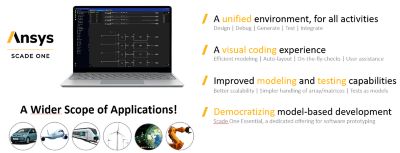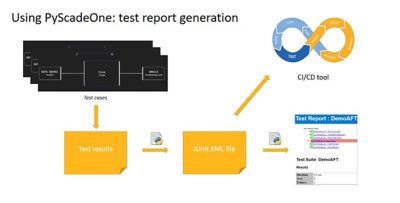-
-
Access Free Student Software
Ansys empowers the next generation of engineers
Students get free access to world-class simulation software.
-
Connect with Ansys Now!
Design your future
Connect with Ansys to explore how simulation can power your next breakthrough.
Countries & Regions
Free Trials
Products & Services
Learn
About
Back
Products & Services
Back
Learn
Ansys empowers the next generation of engineers
Students get free access to world-class simulation software.
Back
About
Design your future
Connect with Ansys to explore how simulation can power your next breakthrough.
Free Trials

Developers working with the Ansys Scade One model-based embedded software development solution often need to extend and tailor the tool to fit their specific development environments and workflows. For example, automating processes within a continuous integration and continuous development (CI/CD) pipeline is essential. This includes automating workflows, transforming data into different formats, and integrating with third-party CI/CD tools to ensure seamless automation.
Developers also need to integrate the model with the rest of the application. For instance, they must incorporate the code generated from Scade One models into a larger system. To do this, they need to automatically generate integration code that allows the generated code to be seamlessly embedded into their application.
The PyScadeOne Python library helps to address these customization and integration issues. Let’s answer a few frequently asked questions about the library.
How does the PyScadeOne library address developer challenges?
PyScadeOne offers capabilities involving accessing or generating all the data that can be manipulated inside of Scade One software. And with this, you are able to automate workflows, as well as automatically import and export data from other formats.

The Ansys Scade One model-based embedded software development solution is enhanced and extended by Python-based application programming interfaces.
What inspired the development of the PyScadeOne library?
From the very beginning, Ansys SCADE software was designed as an open tool, because we understand that every customer operates in a unique environment with different toolchains, embedded targets, and applications. Our goal has always been to ensure that SCADE software could be used in any setup by providing the necessary services and tools to support seamless adaptation and integration. Historically, SCADE software has offered application programming interfaces (APIs) and services to enable tool customization. With Scade One software, we aim to continue this approach and go even further by offering enhanced services and APIs, particularly Python-based ones, to help users extend and tailor the tool to their specific environments.
How does the PyScadeOne library align with the broader goals of the PyAnsys initiative?
The PyAnsys initiative is a company-wide effort to better integrate Ansys tools with the Python ecosystem. The goal is to leverage Python’s extensive library landscape, particularly for numerical computing, data generation, data access, and integration with third-party tools. With the PyScadeOne library, we fully embrace this initiative by standardizing Python as the common scripting language for all tasks around Scade One software. A key strength of the PyScadeOne library is its ability to tap into the rich Python ecosystem, enabling new workflows, automating tasks, and enhancing integration capabilities. Its role is to combine the power of Scade One software with the flexibility of Python to support a wide range of advanced and customized development scenarios.
Like the rest of the PyAnsys tools, the PyScadeOne library is freely available as an open-source project on GitHub and can be installed in any Python environment, just like any other standard Python library.
What value does the PyScadeOne library add in combination with ScadeOne software?
The PyScadeOne unified Python library provides services to access and generate data used within Scade One software. As of the Ansys 2025 R1 release, the library allows users to access models created and edited in Scade One software via built-in services to easily navigate through the model structure. It also provides access to information about the generated code, including its structure and how it maps back to the original model, to automatically generate integration code.
In addition, the PyScadeOne library supports simulation and testing workflows. You can read and create simulation data — such as test inputs and expected outputs — and read test results after executing tests on the host. This enables you to use the PyScadeOne library to generate custom reports or export test data into other formats, making it easier to integrate with third-party CI/CD tools.
How does the PyScadeOne library facilitate integration with other Python-based tools and libraries?
The PyScadeOne library enables access to all the data manipulated within Scade One software through a Python programmatic API. This allows users to leverage the rich Python ecosystem, for example, using libraries like NumPy or SciPy to generate input data for tests. Such data can then be exported in a format compatible with Scade One software for executing test cases. The library also offers all the features you would expect from a standard Python package, including comprehensive documentation and practical examples to help users get started quickly.

An example of using Python to convert test results into a JUnit XML file format is shown. This allows quick, easy integration of Scade One software with continuous integration and continuous development (CI/CD) tools.
What features or enhancements can users look forward to in future releases?
Our goal with the PyScadeOne library is to ensure that all data created, edited, or generated within Scade One software is accessible through its Python API. As more features are added to Scade One software, the PyScadeOne library will be updated accordingly. In the long term, we want full coverage so that every aspect of Scade One software can be accessed programmatically via the PyScadeOne library.
Starting with the Ansys 2025 R2 product release, we intend for you to gain the ability to create models programmatically using Scade One software. We also plan to introduce a new service, a Python wrapper, that allows models to be exported as Python code. This means you can call your Swan models directly from Python, unlocking a wide range of new workflows and integrations with the broader Python ecosystem.
Looking ahead to 2026 R1, we plan to expand the PyScadeOne library with additional services, such as the ability to access project metadata, jobs, and pragmas within your models, further enhancing automation and integration capabilities.
To learn more, watch the webinar “Boost Your Embedded Systems Development With PyScadeOne.”
The Advantage Blog
The Ansys Advantage blog, featuring contributions from Ansys and other technology experts, keeps you updated on how Ansys simulation is powering innovation that drives human advancement.


